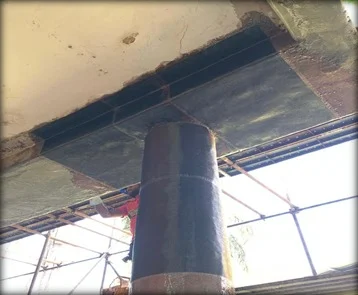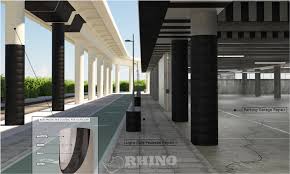Revolutionary Carbon Fiber WRAPPING: The Secret to Earthquake-Proof Buildings
Imagine your house standing Strong while everything around it shakes & crumbles during an earthquake. Sounds like something from a superhero movie, right? Well, this isn't fantasy anymore - it's REALITY thanks to carbon fiber wrapping technology. This amazing material is changing how we make buildings safer during earthquakes, & the best part is that it's much simpler than you might think.When we talk about making buildings earthquake-proof, most people think about thick walls, heavy steel beams, & massive foundations. But what if I told you that a thin layer of special fabric could do the job better? Carbon fiber wrapping is like giving your building a superhero suit that makes it flexible yet incredibly Strong. This technology has been saving lives & protecting property in earthquake-prone areas around the world, from Japan to California.In this article, we'll explore how this INCREDIBLE material works its magic. We'll discover why carbon fiber is so special, learn about the wrapping process, & understand why engineers are calling it the future of earthquake-resistant construction. You'll also learn real-life examples of buildings that survived major earthquakes thanks to this technology. By the end of this article, you'll understand why carbon fiber wrapping might be the most important building safety innovation of our time.
Understanding Carbon Fiber: Nature's Perfect Building Material
Carbon fiber might sound complicated, but it's actually quite Simple to understand. Think of it like the strongest thread you've ever seen - but instead of being made from cotton or wool, it's made from carbon atoms linked together in a special way. These tiny carbon atoms form long chains that are incredibly Strong & lightweight. When thousands of these chains are woven together, they create a fabric that's stronger than steel but weighs much less.The AMAZING thing about carbon fiber is how it behaves under stress. Unlike concrete or brick that can crack & break suddenly, carbon fiber bends & stretches without breaking. Imagine trying to break a single hair versus trying to break a rope made of thousands of hairs woven together - that's the difference we're talking about. This flexibility is exactly what buildings need during earthquakes when the ground moves in unpredictable ways.What makes carbon fiber even more special is its ability to distribute force evenly. When an earthquake hits a building, it creates tremendous pressure on certain parts of the structure. Regular materials might fail at these pressure points, but carbon fiber spreads this force across a larger area. It's like having a really good friend who helps you carry a heavy load - instead of struggling alone, the weight gets shared & becomes manageable.Scientists have tested carbon fiber under extreme conditions, & the results are mind-blowing. This material can stretch up to 15% of its original length without breaking, while concrete can only stretch about 0.1%. This means carbon fiber can handle the back-&-forth motion of earthquakes much Better than traditional building materials. Plus, it doesn't rust, rot, or weaken over time like steel or wood might.

The Wrapping Process: Giving Buildings Their Superhero Suits
Now that we understand what carbon fiber is, let's learn how it actually gets applied to buildings. The process is surprisingly straightforward, kind of like wrapping a present, but with much more precision & care. First, engineers carefully inspect the building to identify weak spots where earthquakes might cause the most damage. These are usually corners, joints, & areas where different parts of the building connect.The actual wrapping process starts with cleaning & preparing the surface. Just like you need a clean surface to put on a Band-Aid, the building's surface must be smooth & free of dirt or loose material. Workers then apply a special glue called epoxy resin to the area that will be wrapped. This glue is super Strong & helps the carbon fiber stick permanently to the building.Next comes the EXCITING part - applying the carbon fiber fabric. Workers carefully wrap the material around columns, beams, & walls, making sure there are no air bubbles or wrinkles. It's similar to wrapping a birthday gift, but instead of making it look pretty, they're making it earthquake-resistant. The fabric needs to overlap slightly at the edges to ensure complete coverage & maximum strength.The final step involves applying more epoxy resin over the carbon fiber & letting it cure or harden. This process usually takes 24 to 48 hours, depending on the weather & temperature. Once it's fully cured, the carbon fiber becomes one with the building structure. The result looks smooth & can even be painted to match the rest of the building. Many people walk past carbon fiber-wrapped buildings every day without even knowing they're looking at cutting-edge earthquake protection technology.
Real-World Success Stories: Buildings That Survived the Shake
The proof of carbon fiber wrapping's effectiveness isn't just in laboratories - it's in real buildings that have faced actual earthquakes & survived. One of the most IMPRESSIVE examples comes from Japan, where a school building wrapped with carbon fiber experienced a magnitude 7.0 earthquake. While nearby buildings suffered significant damage, the wrapped building remained standing with minimal damage. The students & teachers inside were safe, & classes resumed just days later.In California, an old hospital built in the 1960s was facing a dilemma. The building didn't meet modern earthquake safety standards, but rebuilding would cost millions of dollars & take years. Instead, engineers decided to use carbon fiber wrapping to strengthen the structure. When a magnitude 6.4 earthquake struck the area, the hospital continued operating normally. Patients received care without interruption, & the building showed no signs of structural damage.Another remarkable story comes from Italy, where historic buildings present unique challenges. These ancient structures are culturally important but weren't designed to handle earthquakes. Traditional reinforcement methods would destroy their historical appearance. Carbon fiber wrapping provided the Perfect solution because it's nearly invisible once applied. A 12th-century church wrapped with carbon fiber survived a major earthquake that damaged many other historic buildings in the same city.Perhaps the most impressive example is a bridge in New Zealand that was wrapped with carbon fiber as an experiment. When a powerful earthquake hit the region, engineers were amazed to see that the bridge continued carrying traffic while other bridges in the area had to be closed for safety inspections. The carbon fiber had prevented the kind of structural damage that typically occurs during seismic events. This SUCCESS led to carbon fiber wrapping becoming standard practice for infrastructure projects in earthquake-prone areas.

Why Carbon Fiber Wrapping is the Future of Earthquake Safety
The advantages of carbon fiber wrapping go far beyond just earthquake protection. Unlike traditional reinforcement methods that require tearing down walls or adding bulky steel supports, carbon fiber wrapping can be applied to existing buildings without major disruption. This means schools, hospitals, & businesses can continue operating normally during the strengthening process. Imagine trying to renovate a hospital while patients are being treated - carbon fiber makes this possible.Cost is another HUGE advantage that makes this technology accessible to more people. Traditional seismic retrofitting can cost hundreds of thousands of dollars & take months to complete. Carbon fiber wrapping typically costs 50-70% less & can be finished in weeks rather than months. This affordability means that smaller buildings like homes, schools, & local businesses can now afford earthquake protection that was previously only available to large corporations. The environmental benefits are also worth considering. Carbon fiber wrapping extends the life of existing buildings instead of requiring them to be torn down & rebuilt. This reduces construction waste & saves the energy that would be needed to manufacture new building materials. Additionally, carbon fiber itself is recyclable, making it an environmentally RESPONSIBLE choice for building safety.Looking toward the future, researchers are developing even more advanced carbon fiber materials. Some new types can actually sense when they're under stress & send signals to building managers. Others are being designed to repair themselves automatically if small cracks develop. These innovations suggest that carbon fiber wrapping will become even more effective & easier to use in the coming years.
Carbon fiber wrapping represents a revolutionary step forward in making our buildings safer during earthquakes. This incredible technology transforms vulnerable structures into resilient ones without the need for expensive, time-consuming renovations. From schools in Japan to hospitals in California, real-world examples prove that carbon fiber wrapping can mean the difference between life & death when the earth starts shaking.The beauty of this technology lies in its SIMPLICITY & effectiveness. By applying a thin layer of carbon fiber fabric to critical areas of a building, engineers can dramatically increase its ability to survive seismic events. The material's unique properties - its strength, flexibility, & ability to distribute forces - make it perfectly suited for earthquake protection. Plus, the relatively low cost & quick installation process make it accessible to a wide range of building owners.As we face an uncertain future with increasing seismic activity in many parts of the world, carbon fiber wrapping offers hope. It provides a practical, affordable solution that can protect both new & existing buildings. Whether you're a homeowner in California, a school administrator in Japan, or a business owner anywhere in an earthquake zone, this technology could be the key to keeping your property & the people inside it SAFE.The question isn't whether we should adopt carbon fiber wrapping technology - it's how quickly we can implement it on a larger scale. Every building that receives this protection is a step toward a safer, more resilient future. If you own or manage a building in an earthquake-prone area, consider investigating carbon fiber wrapping. It might just be the best investment you ever make in safety & peace of mind.


